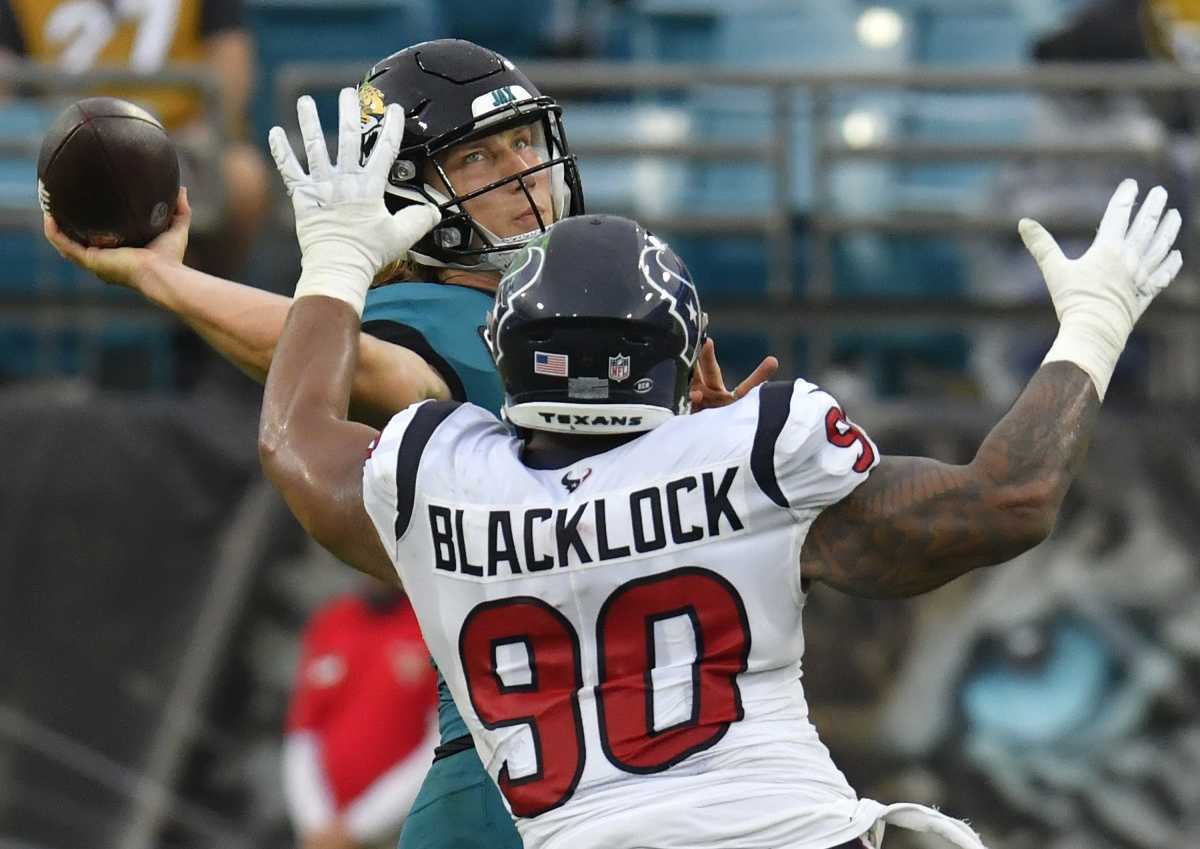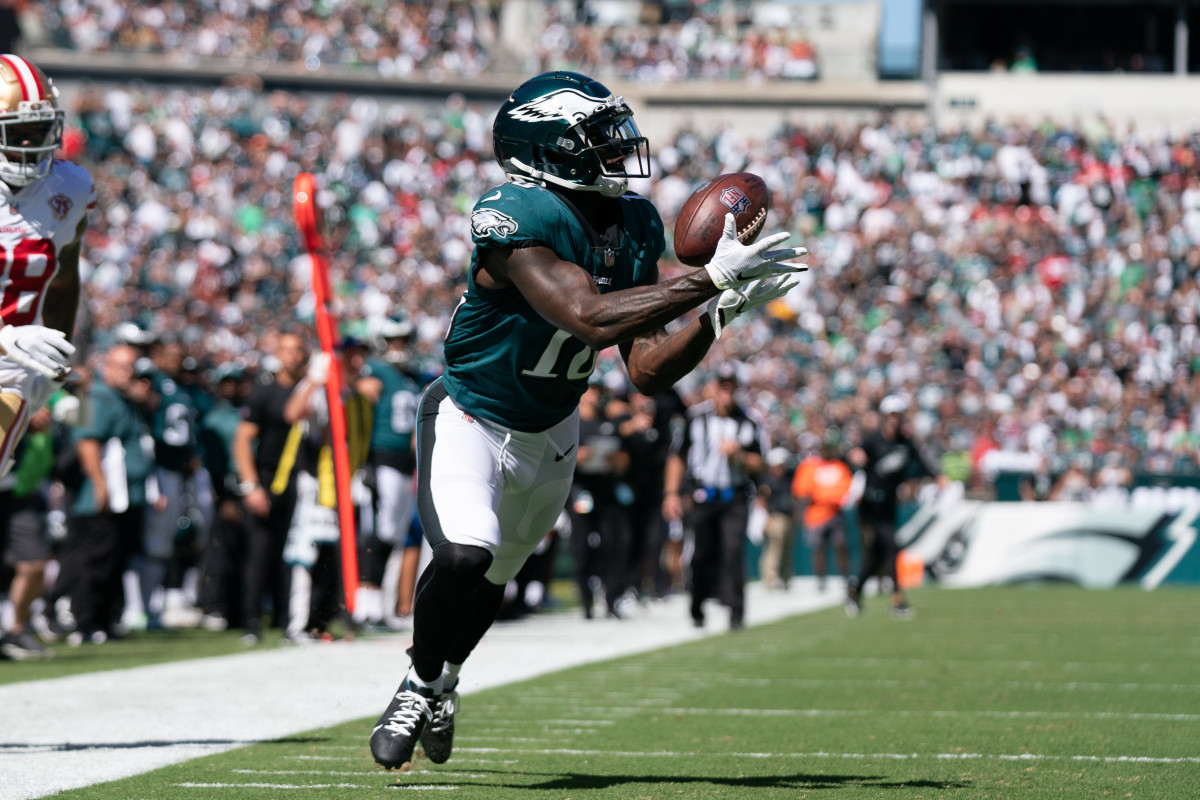Why the Vikings Traded for Ross Blacklock and Jalen Reagor and How They'll Fit
This week, the Vikings surprisingly cast aside defensive tackle Armon Watts and wide receiver Ihmir Smith-Marsette, two talented football players who were expected — by outsiders, at least — to play sizable roles in 2022. To replace them, GM Kwesi Adofo-Mensah made a pair of moves to acquire Ross Blacklock and Jalen Reagor from the Texans and Eagles, respectively.
We can't know exactly why Adofo-Mensah and the Vikings decided to make those moves, but we can glean a bit of insight from his public comments at a Thursday press conference and use educated speculation to fill in the blanks.
Blacklock was the first move. Mere minutes after shocking news broke that the Vikings had waived Watts, it was announced that they had traded a sixth-round pick to Houston for Blacklock and a seventh. That amount of draft compensation is nearly meaningless, suggesting the Texans wanted to get anything they could for a former high draft pick who has disappointed in his two NFL seasons.
From the Vikings' perspective, going from Watts to Blacklock saved them roughly $1.2 million in cap space, which is an important part of the calculus. From a football standpoint, though, it's somewhat difficult to figure out the logic of the swap. Watts has inarguably been a better NFL defensive lineman than Blacklock, breaking out last season with 33 pressures and five sacks as Minnesota's most productive interior pass rusher. Watts, who was claimed by the Bears on waivers, played with the Vikings' first-team defense for much of training camp.
Money aside, it feels like there are three factors that went into the decision to waive Watts and acquire Blacklock: timeline, upside, and scheme fit.
Adofo-Mensah loves to use the term "time horizons" when talking about football decisions. Basically, that refers to the idea of not just looking at the current season when making moves, but planning things out with an eye on the future as well. Blacklock, 24, is two years younger than Watts. He has two years left on his rookie contract, whereas Watts is heading into a contract year. That means the Vikings gain an additional year of control at the position, allowing them to coach up Blacklock over the next two seasons and see how he might fit into their long-term plans beyond that.
"You’re really trying to always figure out how your team shapes and fits and the different skill sets you’re trying to add," Adofo-Mensah said. "We thought that was an opportunity to add somebody in Blacklock who’s got a really good pass-rush skill set, really disruptive in that phase. In the run game, also disruptive. So we’re trying to add that skill set. Also, along our time horizon of where we’re trying to compete in this league ... sometimes those deals make sense."

Back in 2020, Blacklock was the No. 40 overall pick out of TCU. He was coming off a 3.5-sack, 9-TFL final collegiate season and helped his stock by running a 4.9 40 with a great ten-yard split at 6'3", 290 pounds. In his pre-draft scouting report, NFL.com's Lance Zierlein described Blacklock as a "relentless pass rusher with elite lateral quickness and change of direction" and said he had "rare movement talent and intriguing rush potential." Zierlein also cautioned that Blacklock needed plenty of development in his technique, especially when it came to taking on blocks in run defense.
In two seasons with the Texans, Blacklock's perceived weaknesses showed up far more than his strengths. He played just 254 defensive snaps as a rookie and was graded dead last by Pro Football Focus out of 133 interior defensive linemen who played at least 200 snaps. Blacklock improved in year two, particularly as a pass rusher. He played over 450 snaps, showing flashes of penetration ability as he recorded 25 pressures and a pair of sacks. But because of poor PFF grades in the run defense and tackling categories, Blacklock only jumped up to 100th out of 145 DTs in terms of overall grade.
PFF grades are an imperfect metric, but there's a reason the lowly Texans moved on from him after two years without getting much of anything in return.
Still, the Vikings clearly view Blacklock as a good fit for their scheme with the upside to improve in a new situation. The traits that made him a top-40 pick just two years ago haven't disappeared; defensive line coaches Chris Rumph and A'lique Terry will try to help Blacklock continue to develop and take a leap in his third season. And although Watts went from 2019 sixth-round pick to promising interior pass rusher, he had some issues in run defense too.
It helps that Blacklock won't be asked to be a star. The Vikings have a pair of top-tier starting defensive tackles in Harrison Phillips and Dalvin Tomlinson, both of whom are stout against the run. After those two, they like what they have in depth players like Jonathan Bullard and James Lynch. That means Blacklock doesn't need to come in and step into Watts' role as a 1-for-1 replacement. The Vikings think he'll fit well as an interior pass rusher who can be put into situations that maximize what he does well.
One day later, the Vikings made a similarly surprising move by swinging a trade for Reagor and then releasing Smith-Marsette, who appeared to be in line to be their No. 4 receiver after Bisi Johnson's ACL injury. They sent the Eagles the seventh-round pick they got from the Texans in the Blacklock deal, plus a conditional 2024 pick that will either be a fourth or a fifth-rounder, depending on whether or not certain unspecified statistical marks are reached. Smith-Marsette, like Watts, was claimed on waivers by the Bears, giving him a chance to potentially enact revenge on his old team for years to come.
Reagor was famously selected one spot in front of Justin Jefferson in the first round of the 2020 draft. As Jefferson soared to near-immediate superstardom, becoming the first player in NFL history with 3,000 receiving yards in their first two seasons, Reagor struggled to establish himself in Philly and was labeled as a bust.
When it comes to this move, the "time horizons" explanation doesn't work in the same way. Reagor is eight months older than Smith-Marsette and was drafted one year earlier. He almost certainly won't have his 2024 fifth-year option picked up, meaning the Vikings swapped out a player with three years left on his rookie contract for a player with two years left on a notably more expensive rookie deal ($1.8 million cap hit this year, $2.4 million cap hit next year).
This is about fit, upside, and special teams. Reagor is just 23 years old and was a super exciting prospect coming out of TCU, where he was teammates with Blacklock, former Vikings first-round pick Jeff Gladney — who tragically passed away in May — and Vikings offensive lineman Austin Schlottmann.
Reagor broke out as a junior in 2018 with over 1,200 yards from scrimmage and 11 touchdowns despite shaky quarterback play. He has 4.47 speed, a sturdy build at 5'11", 197 pounds, and remarkable explosiveness. Zierlein noted in his pre-draft scouting report that Reagor was inconsistent in his focus and route-running, but described him as a "smooth athlete with blazing speed" and "electric with the ball in his hands."
It never came to fruition with the Eagles. Reagor has a meager 64/695/3 receiving line through two seasons and was charged with four drops last year. He averaged just 0.67 yards per route run in 2021, ranking 134th out of 139 receivers with at least 20 targets.
Like with Blacklock, the Vikings are making a bet on Reagor having potential that he can unlock in a new situation. He has shown some promise as an intermediate receiver and can be dangerous as a gadget weapon because of his natural skills as a ballcarrier. Vikings wide receivers coach Keenan McCardell is excellent at his job, so maybe he can help Reagor become a more complete player.
"We always look at opportunities — we call it 'no stone unturned,' Adofo-Mensah said. "We’re always looking at opportunities to improve the team. We saw Jalen as somebody who has a really great skill set individually, but also how he complements that (receiver) room and then also our offensive football team. So ultimately, when the value proposition meets kind of what you have in mind in terms of vision, you make those decisions."

It's been a disappointing start to his career for Reagor, but he's still young and talented. He should slot in as the Vikings' fourth receiver behind Jefferson, Adam Thielen, and K.J. Osborn, and his speed and YAC ability give them someone with a slightly different skill set than what they already have. After catching passes from Carson Wentz and Jalen Hurts in Philly, Reagor will be playing with Kirk Cousins, who has more experience and arm talent than either of his previous QBs.
With both Blacklock and Reagor, the Vikings balanced what their scouts and coaches saw out of them as draft prospects with what they've become over their two seasons in the NFL.
"Kevin and I get together with our new staff and our coaching staff and kind of talk about the player that we saw them being coming out and also the new information we’ve gotten," Adofo-Mensah said. "All of that is combined into our decision and ultimately it’s not a perfect science, it’s a little bit of art, a little bit of science, and we like the decision we made."
Perhaps the main area where Reagor can contribute right away is as a punt returner. He averaged 17.8 yards per return and scored two touchdowns in that phase at TCU, and has averaged 9.2 yards with one TD in the NFL. He needs to become a bit more consistent at catching the ball cleanly, but Reagor has the natural instincts and athleticism to be dangerous as a punt returner.
"We're going to give him every opportunity to do that," head coach Kevin O'Connell said. "We have some other guys on the roster we feel good about if need be, but Jalen's excited about that opportunity. I think he's got some good experience doing that, obviously some real flashes of doing that at a high level. We'll get him going from day one today and see where's he at going into Green Bay. If he's comfortable going back there and he's our best option, in our opinion, to give us a chance to impact the game, he'll be back there."
In aggregate, the Vikings used a sixth-rounder and a fourth or fifth-rounder to go from Watts and Smith-Marsette to Blacklock and Reagor, two reclamation projects who entered the league with much higher draft pedigree than the players they're replacing.
If it pans out and the Vikings can help Blacklock and Reagor have their best NFL seasons in Minnesota, the upside could be pretty substantial. If it doesn't — and if Watts and Smith-Marsette turn into important players for the division rival Bears — this collection of moves could go from surprising to regrettable.
Thanks for reading. Make sure to bookmark this site and check back daily for the latest Vikings news and analysis all offseason long. Also, follow me on Twitter and feel free to ask me any questions on there.
